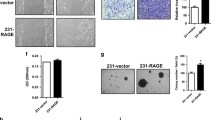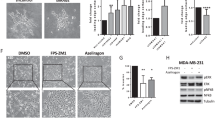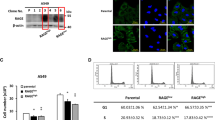Abstract
S100A8/A9 proteins are members of EF-hand calcium-binding proteins secreted by neutrophils and activated monocytes. S100A8/A9 has cell growth-promoting activity at low concentrations by binding to the receptor for advanced glycation end products (RAGE). In this study, we report for the first time that S100A8/A9 promoted the invasion of breast cancer cells depending on RAGE. In addition, RAGE binding to S100A8/A9 promoted the phosphorylation of LIN-11, Isl1, and MEC-3 protein domain kinase, as well as cofilin. This phosphorylation is a critical step in cofilin recycling and actin polymerization. Interestingly, RAGE binding to S100A8/A9 enhanced cell mesenchymal properties and induced epithelial–mesenchymal transition. Mechanistically, RAGE binding to S100A8/A9 stabilized Snail through the NF-κB signaling pathway. Based on these observations, RAGE expression in breast cancer cells was associated with lymph node and distant metastases in patients with invasive ductal carcinoma. Moreover, RAGE binding to S100A8/A9 promoted lung metastasis in vivo. In summary, our in vitro and in vivo results indicated that RAGE binding to S100A8/A9 played an important role in breast cancer invasion/metastasis. This study identified both RAGE and S100A8/A9 as potential anti-invasion targets for therapeutic intervention in breast cancer.





Similar content being viewed by others
References
Mukherjee D, Zhao J (2013) The role of chemokine receptor CXCR4 in breast cancer metastasis. Am J Cancer Res 3(1):46–57
Ben-Baruch A (2008) Organ selectivity in metastasis: regulation by chemokines and their receptors. Clin Exp Metastasis 25(4):345–356. doi:10.1007/s10585-007-9097-3
Mantovani A, Allavena P, Sica A, Balkwill F (2008) Cancer-related inflammation. Nature 454(7203):436–444. doi:10.1038/nature07205
Vogl T, Tenbrock K, Ludwig S, Leukert N, Ehrhardt C, van Zoelen MA, Nacken W, Foell D, van der Poll T, Sorg C, Roth J (2007) Mrp8 and Mrp14 are endogenous activators of Toll-like receptor 4, promoting lethal, endotoxin-induced shock. Nat Med 13(9):1042–1049
Ghavami S, Rashedi I, Dattilo BM, Eshraghi M, Chazin WJ, Hashemi M, Wesselborg S, Kerkhoff C, Los M (2008) S100A8/A9 at low concentration promotes tumor cell growth via RAGE ligation and MAP kinase-dependent pathway. J Leukoc Biol 83(6):1484–1492
Saha A, Lee YC, Zhang Z, Chandra G, Su SB, Mukherjee AB (2010) Lack of an endogenous anti-inflammatory protein in mice enhances colonization of B16F10 melanoma cells in the lungs. J Biol Chem 285(14):10822–10831. doi:10.1074/jbc.M109.083550
Ang CW, Nedjadi T, Sheikh AA, Tweedle EM, Tonack S, Honap S, Jenkins RE, Park BK, Schwarte-Waldhoff I, Khattak I, Azadeh B, Dodson A, Kalirai H, Neoptolemos JP, Rooney PS, Costello E (2010) Smad4 loss is associated with fewer S100A8-positive monocytes in colorectal tumors and attenuated response to S100A8 in colorectal and pancreatic cancer cells. Carcinogenesis 31(9):1541–1551. doi:10.1093/carcin/bgq137
Bierhaus A, Stern DM, Nawroth PP (2006) RAGE in inflammation: a new therapeutic target? Curr Opin Investig Drugs 7(11):985–991
Leclerc E, Fritz G, Weibel M, Heizmann CW, Galichet A (2007) S100B and S100A6 differentially modulate cell survival by interacting with distinct RAGE (receptor for advanced glycation end products) immunoglobulin domains. J Biol Chem 282(43):31317–31331. doi:10.1074/jbc.M703951200
Donato R (2007) RAGE: a single receptor for several ligands and different cellular responses: the case of certain S100 proteins. Curr Mol Med 7(8):711–724
Turovskaya O, Foell D, Sinha P, Vogl T, Newlin R, Nayak J, Nguyen M, Olsson A, Nawroth PP, Bierhaus A, Varki N, Kronenberg M, Freeze HH, Srikrishna G (2008) RAGE, carboxylated glycans and S100A8/A9 play essential roles in colitis-associated carcinogenesis. Carcinogenesis 29(10):2035–2043. doi:10.1093/carcin/bgn188
Denis M, Tanguy M, Chidaine B, Laisney MJ, Megraud F, Fravalo P (2011) Description and sources of contamination by Campylobacter spp. of river water destined for human consumption in Brittany, France. Pathol Biol (Paris) 59(5):256–263. doi:10.1016/j.patbio.2009.10.007
Tafani M, Schito L, Pellegrini L, Villanova L, Marfe G, Anwar T, Rosa R, Indelicato M, Fini M, Pucci B, Russo MA (2011) Hypoxia-increased RAGE and P2X7R expression regulates tumor cell invasion through phosphorylation of Erk1/2 and Akt and nuclear translocation of NF-{kappa}B. Carcinogenesis 32(8):1167–1175. doi:10.1093/carcin/bgr101
Nasser MW, Qamri Z, Deol YS, Ravi J, Powell CA, Trikha P, Schwendener RA, Bai XF, Shilo K, Zou X, Leone G, Wolf R, Yuspa SH, Ganju RK (2012) S100A7 enhances mammary tumorigenesis through upregulation of inflammatory pathways. Cancer Res 72(3):604–615. doi:10.1158/0008-5472.CAN-11-0669
Hunter MJ, Chazin WJ (1998) High level expression and dimer characterization of the S100 EF-hand proteins, migration inhibitory factor-related proteins 8 and 14. J Biol Chem 273(20):12427–12435
van den Bos C, Rammes A, Vogl T, Boynton R, Zaia J, Sorg C, Roth J (1998) Copurification of P6, MRP8, and MRP14 from human granulocytes and separation of individual proteins. Protein Expr Purif 13(3):313–318. doi:10.1006/prep.1998.0917
Guo H, Gu F, Li W, Zhang B, Niu R, Fu L, Zhang N, Ma Y (2009) Reduction of protein kinase C zeta inhibits migration and invasion of human glioblastoma cells. J Neurochem 109(1):203–213
Sun R, Gao P, Chen L, Ma D, Wang J, Oppenheim JJ, Zhang N (2005) Protein kinase C zeta is required for epidermal growth factor-induced chemotaxis of human breast cancer cells. Cancer Res 65(4):1433–1441
Shi L, Sun X, Zhang J, Zhao C, Li H, Liu Z, Fang C, Wang X, Zhao C, Zhang X, Zhou F, Lu S, Luo R, Zhang B (2013) Gab2 expression in glioma and its implications for tumor invasion. Acta Oncol 52(8):1739–1750
Ludowyke RI, Kawasugi K, French PW (1994) PMA and calcium ionophore induce myosin and F-actin rearrangement during histamine secretion from RBL-2H3 cells. Cell Motil Cytoskeleton 29(4):354–365. doi:10.1002/cm.970290408
Chen P, Li K, Liang Y, Li L, Zhu X (2012) High NUAK1 expression correlates with poor prognosis and involved in NSCLC cells migration and invasion. Exp Lung Res. doi:10.3109/01902148.2012.744115
Shaikh FM, Seales EC, Clem WC, Hennessy KM, Zhuo Y, Bellis SL (2008) Tumor cell migration and invasion are regulated by expression of variant integrin glycoforms. Exp Cell Res 314(16):2941–2950
Lu S, Niu N, Guo H, Tang J, Guo W, Liu Z, Shi L, Sun T, Zhou F, Li H, Zhang J, Zhang B (2013) ARK5 promotes glioma cell invasion, and its elevated expression is correlated with poor clinical outcome. Eur J Cancer 49(3):752–763
Larue L, Bellacosa A (2005) Epithelial–mesenchymal transition in development and cancer: role of phosphatidylinositol 3′ kinase/AKT pathways. Oncogene 24(50):7443–7454
Min C, Eddy SF, Sherr DH, Sonenshein GE (2008) NF-kappaB and epithelial to mesenchymal transition of cancer. J Cell Biochem 104(3):733–744
Li CW, Xia W, Huo L, Lim SO, Wu Y, Hsu JL, Chao CH, Yamaguchi H, Yang NK, Ding Q, Wang Y, Lai YJ, LaBaff AM, Wu TJ, Lin BR, Yang MH, Hortobagyi GN, Hung MC (2012) Epithelial–mesenchymal transition induced by TNF-alpha requires NF-kappaB-mediated transcriptional upregulation of Twist1. Cancer Res 72(5):1290–1300
Chua HL, Bhat-Nakshatri P, Clare SE, Morimiya A, Badve S, Nakshatri H (2007) NF-kappaB represses E-cadherin expression and enhances epithelial to mesenchymal transition of mammary epithelial cells: potential involvement of ZEB-1 and ZEB-2. Oncogene 26(5):711–724
Ichikawa M, Williams R, Wang L, Vogl T, Srikrishna G (2011) S100A8/A9 activate key genes and pathways in colon tumor progression. Mol Cancer Res 9(2):133–148
Loser K, Vogl T, Voskort M, Lueken A, Kupas V, Nacken W, Klenner L, Kuhn A, Foell D, Sorokin L, Luger TA, Roth J, Beissert S (2010) The Toll-like receptor 4 ligands Mrp8 and Mrp14 are crucial in the development of autoreactive CD8+ T cells. Nat Med 16(6):713–717
Song X, Chen X, Yamaguchi H, Mouneimne G, Condeelis JS, Eddy RJ (2006) Initiation of cofilin activity in response to EGF is uncoupled from cofilin phosphorylation and dephosphorylation in carcinoma cells. J Cell Sci 119(Pt 14):2871–2881
Pollard TD, Borisy GG (2003) Cellular motility driven by assembly and disassembly of actin filaments. Cell 112(4):453–465
Shin SR, Sanchez-Velar N, Sherr DH, Sonenshein GE (2006) 7,12-dimethylbenz(a)anthracene treatment of a c-rel mouse mammary tumor cell line induces epithelial to mesenchymal transition via activation of nuclear factor-kappaB. Cancer Res 66(5):2570–2575
Yang MH, Wu MZ, Chiou SH, Chen PM, Chang SY, Liu CJ, Teng SC, Wu KJ (2008) Direct regulation of TWIST by HIF-1alpha promotes metastasis. Nat Cell Biol 10(3):295–305
Yoon CH, Kim MJ, Lee H, Kim RK, Lim EJ, Yoo KC, Lee GH, Cui YH, Oh YS, Gye MC, Lee YY, Park IC, An S, Hwang SG, Park MJ, Suh Y, Lee SJ (2012) PTTG1 oncogene promotes tumor malignancy via epithelial to mesenchymal transition and expansion of cancer stem cell population. J Biol Chem 287(23):19516–19527. doi:10.1074/jbc.M111.337428
Gebhardt C, Nemeth J, Angel P, Hess J (2006) S100A8 and S100A9 in inflammation and cancer. Biochem Pharmacol 72(11):1622–1631
Acknowledgments
This work was supported by the National Scientific Foundation of China (81072068), the Young and Middle-Aged Scientists Research Awards Foundation of Shandong Province (2010BSB14050 and BS2011YY060), and the Foundation of Shandong Educational Committee (J12LK03, J10LF64, and J13LK03).
Conflict of interest
The authors declare no conflict of interest.
Author information
Authors and Affiliations
Corresponding author
Additional information
Chonggao Yin, Hongli Li, and Baogang Zhang have contributed equally to this work.
Electronic supplementary material
Below is the link to the electronic supplementary material.
10549_2013_2737_MOESM1_ESM.tif
Fig. S1 Comparison of cell proliferation in breast cancer cell lines. Each data point was an average of triplicate assays. Columns, mean of triplicate measurements; Bars, standard deviation (TIFF 78 kb)
10549_2013_2737_MOESM2_ESM.tif
Fig. S2 Comparison of cell proliferation in Scr/MDA231 and SiRAGE/MDA231 cells. Each data point was an average of triplicate assays. Columns, mean of triplicate measurements; Bars, standard deviation (TIFF 78 kb)
Rights and permissions
About this article
Cite this article
Yin, C., Li, H., Zhang, B. et al. RAGE-binding S100A8/A9 promotes the migration and invasion of human breast cancer cells through actin polymerization and epithelial–mesenchymal transition. Breast Cancer Res Treat 142, 297–309 (2013). https://doi.org/10.1007/s10549-013-2737-1
Received:
Accepted:
Published:
Issue Date:
DOI: https://doi.org/10.1007/s10549-013-2737-1




